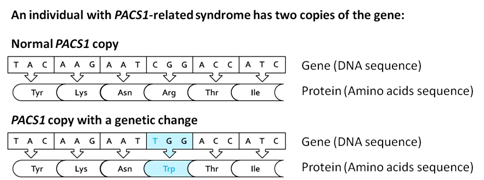The PACS1-related syndrome is in most cases caused by an identical mutation in the PACS1 gene occurring in all affected individuals (Figure 5). This PACS1 genetic change is called c.607C>T, p.(Arg203Trp). One individual had been reported with a c.608G>A, p.Arg203Gln mutation.

Figure 5. Disease-causing change c.607C>T, p.(Arg203Trp) in one of the two copies of PACS1.
A gene (i.e. a small piece of our genetic code or DNA) is an instruction to assemble a sequence of several amino acids in the correct order to produce a protein, which is a structure essential for the formation and proper functioning of our body. If you think about the PACS1 gene as a sequence of letters in a sentence, which code for words, this specific PACS1 genetic variant is a change of a single letter (C) for another letter (T), resulting in a change of an amino acid (Arg) for another amino acid (Trp) in the protein. This genetic change disrupts the information encoded by PACS1, which becomes non-readable.
The PACS1 gene is thought to be important for brain development and function, as well as for the formation of craniofacial structures. Thus, it is thought that the disturbance of this processes may result in the patient’s intellectual and facial characteristics.
The clinical consequences of other PACS1 variants is still to be investigated.
What is needed to confirm the diagnosis of PACS1-related syndrome?
The diagnosis of PACS1-related syndrome is confirmed by performing genetic testing in an affected individual, which enables the detection of a disease-causing change in the PACS1 gene.
There are two possible strategies to identify a PACS1 change:
- If the individual’s characteristics are not sufficient to raise the suspicion of PACS1-related syndrome (for example, because they overlap with the characteristics observed in other genetic disorders), the DNA sequence of multiple genes, including PACS1, will be analysed using a multi-gene panel or exome sequencing.
- If the individual’s characteristics raise the suspicion of PACS1-related syndrome, only the DNA sequence of the PACS1 gene will be analysed;
The genetic testing can be arranged by a clinical geneticist and involves the collection of a sample of blood or saliva from the affected individual (and eventually the parents). Analysing the DNA of the patient and comparing it with the parents’ DNA may facilitate the detection of a disease-causing change in the PACS1 gene that is not present in the healthy parents (i.e. a “de novo” change).
